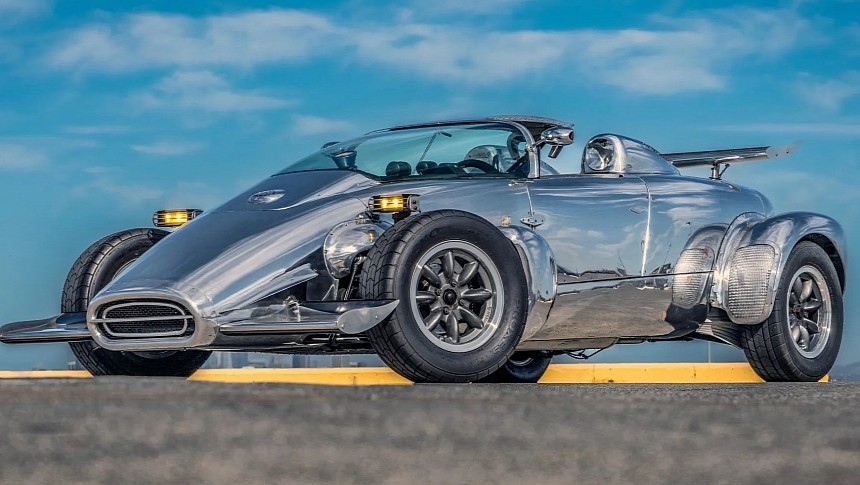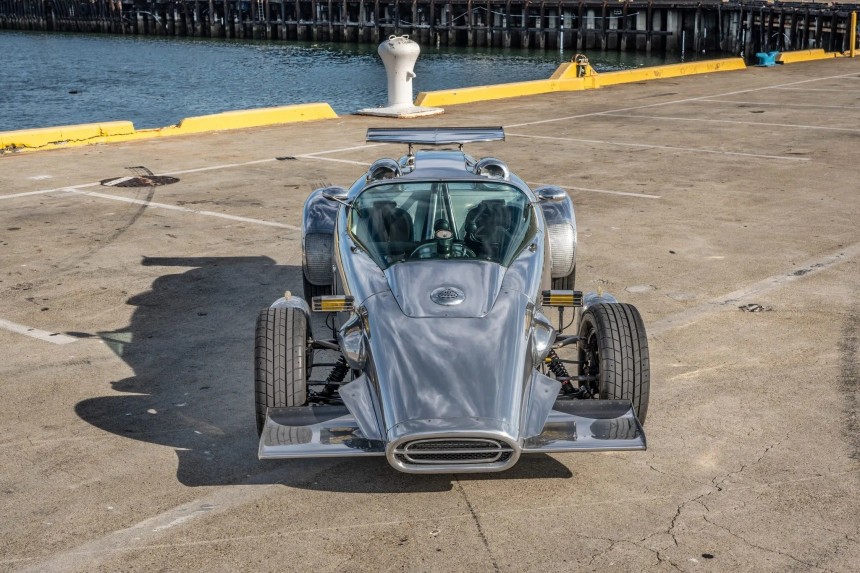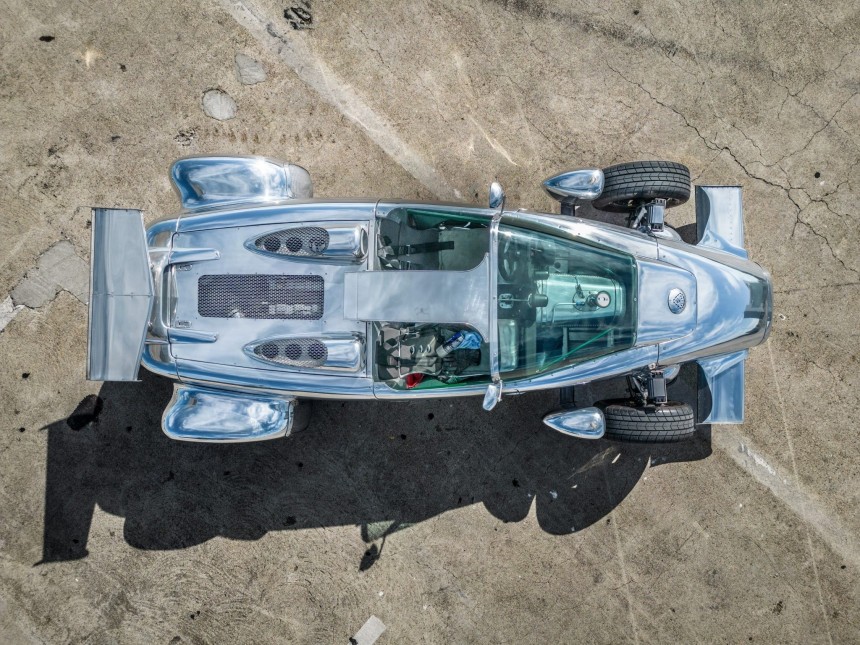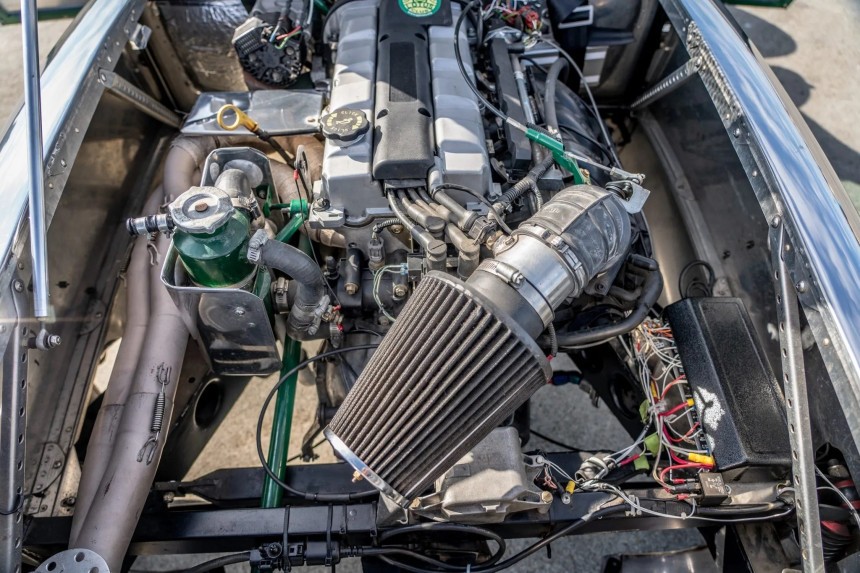You wouldn't tell by the looks of it, but the car pictured above is a Lotus Europa, a machine considered by many enthusiasts one of the best-handling sports cars ever built.
The original Lotus Europa did look like nothing else on the road at the time of its release, but the unit here is so unique that even an expert in the model would have a hard time distinguishing it as a Europa. That's because it has been highly modified. It received a new aluminum alloy body, a new engine, and a slew of other modifications that basically transformed it into a whole different car.
Initially introduced in 1966, the Lotus Europa was produced over three major generations between the release year and 1975, and it was one of the most important British sports cars of that era. It was designed by Lotus Cars, a carmaker that built a reputation for making lightweight and fine-handling sports cars and racing cars.
Back then, almost all the cars driving on the roads still had the engine in the front, but Lotus Cars did things differently with the Europa, as the car was one of the world's first mass-produced mid-engine vehicles designed for use on public roads (the true mid-engine pioneer was the Matra Djet).
The mid-engined configuration was already broadly used in Formula 1 and LeMans cars by the mid-1960s. Considering engineering legend Colin Chapman, the founder of the British brand, was a successful F1 car developer, it made perfect sense Lotus Cars would bring the same layout to their road cars.
Besides the mid-engine design, the Europa was unique in many other ways. Built on a steel backbone chassis just like its predecessor, the Lotus Elan, the Europa boasted a ground-breaking aerodynamic body design, independent front and rear suspension, and incredibly fine handling thanks to its low weight. It provided a perfectly balanced road appeal and raw racing potential.
Speaking of weight, the car's unique body shell was made of fiberglass, which helped make it one of the lightest vehicles of its time, with a curb weight of just 1,350 pounds (610 kg). For a bit of perspective, a current Mazda Miata weighs just under 2400 pounds (1,080 kg), while a Fiat 500 tips the scales at 2300 pounds (1,043 kg).
The only issue Chapman encountered when building the car was the lack of engines and transmissions for mid-engine configurations in production cars. Chapman and his team eventually settled on the inline-four cylinder engine found under the hood of the Renault 16. This was a mill for a front-wheel-drive car, so they fixed the problem by flipping it 180º and repositioning the differential crownwheel so that the Europa would have one reverse and four forward speeds and not the other way around.
Just imagine a World Championship-winning F1 team developing and releasing their own road car with similar specs and an affordable price. It was only natural for the world to stand to attention. It's no wonder Lotus produced and sold nearly 10,000 units of the Europa, becoming the company's best-selling model up to that point in time.
Today, the Lotus Europa is a highly coveted car among collectors and enthusiasts. The unit in question here is a 1970 example, meaning it's a Series 2 version, but the changes performed on its body make it unrecognizable. The original Europa chassis was kept, but the car now sports a new hand-formed alloy body instead of the fiberglass one, uprated front and rear suspension and brakes, and a new engine. The original Renault mill was replaced by a 2.0 liter Zetec DOHC inline-four delivering considerably more power and sending it to the rear wheels via a Renault-sourced five-speed manual transaxle.
The car is about to roll across the auction block, and the current owner says they acquired it in 2005 as a non-running project. They spent several years modifying it, fitting a shiny custom-made bodywork, front and rear adjustable wings, a custom plexiglass windshield, headrest fairings, cycle-style rear fenders, and many other details.
Additional changes were made under the body, including the addition of more advanced suspension and improved brakes. The front suspension arms were replaced with chromoly steel tubes, a replacement brake master cylinder and a brake-bias controller were added, and a heavier front sway bar was installed on modified mounting points.
Another unusual detail is the removable aluminum panel that protects the underside of the engine and transaxle. The modified Europa rides on Panasport-style 13″ wheels shod in grippy 205/60 Toyo Proxes RA1 tires.
As for the interior of the car, it features aluminum seats with black foam seatback padding and green vinyl lower cushions, a three-point roll bar that connects to the custom overhead structure, a three-spoke MOMO steering wheel, and a custom gas pedal.
This 1970 Lotus Europa is indeed quite different from the original, but it's still focused on low weight, improved handling, and extra power. If you are interested, it is offered out of Piedmont, California, with a California title in hand.
Initially introduced in 1966, the Lotus Europa was produced over three major generations between the release year and 1975, and it was one of the most important British sports cars of that era. It was designed by Lotus Cars, a carmaker that built a reputation for making lightweight and fine-handling sports cars and racing cars.
Back then, almost all the cars driving on the roads still had the engine in the front, but Lotus Cars did things differently with the Europa, as the car was one of the world's first mass-produced mid-engine vehicles designed for use on public roads (the true mid-engine pioneer was the Matra Djet).
Besides the mid-engine design, the Europa was unique in many other ways. Built on a steel backbone chassis just like its predecessor, the Lotus Elan, the Europa boasted a ground-breaking aerodynamic body design, independent front and rear suspension, and incredibly fine handling thanks to its low weight. It provided a perfectly balanced road appeal and raw racing potential.
Speaking of weight, the car's unique body shell was made of fiberglass, which helped make it one of the lightest vehicles of its time, with a curb weight of just 1,350 pounds (610 kg). For a bit of perspective, a current Mazda Miata weighs just under 2400 pounds (1,080 kg), while a Fiat 500 tips the scales at 2300 pounds (1,043 kg).
The only issue Chapman encountered when building the car was the lack of engines and transmissions for mid-engine configurations in production cars. Chapman and his team eventually settled on the inline-four cylinder engine found under the hood of the Renault 16. This was a mill for a front-wheel-drive car, so they fixed the problem by flipping it 180º and repositioning the differential crownwheel so that the Europa would have one reverse and four forward speeds and not the other way around.
Today, the Lotus Europa is a highly coveted car among collectors and enthusiasts. The unit in question here is a 1970 example, meaning it's a Series 2 version, but the changes performed on its body make it unrecognizable. The original Europa chassis was kept, but the car now sports a new hand-formed alloy body instead of the fiberglass one, uprated front and rear suspension and brakes, and a new engine. The original Renault mill was replaced by a 2.0 liter Zetec DOHC inline-four delivering considerably more power and sending it to the rear wheels via a Renault-sourced five-speed manual transaxle.
The car is about to roll across the auction block, and the current owner says they acquired it in 2005 as a non-running project. They spent several years modifying it, fitting a shiny custom-made bodywork, front and rear adjustable wings, a custom plexiglass windshield, headrest fairings, cycle-style rear fenders, and many other details.
Another unusual detail is the removable aluminum panel that protects the underside of the engine and transaxle. The modified Europa rides on Panasport-style 13″ wheels shod in grippy 205/60 Toyo Proxes RA1 tires.
As for the interior of the car, it features aluminum seats with black foam seatback padding and green vinyl lower cushions, a three-point roll bar that connects to the custom overhead structure, a three-spoke MOMO steering wheel, and a custom gas pedal.
This 1970 Lotus Europa is indeed quite different from the original, but it's still focused on low weight, improved handling, and extra power. If you are interested, it is offered out of Piedmont, California, with a California title in hand.

































